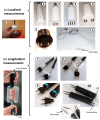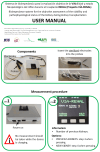Development and Validation in Porcine and Human Models of a Bioimpedance Spectroscopy System for the Objective Assessment of Kidney Graft Viability
- PMID: 40363308
- PMCID: PMC12074221
- DOI: 10.3390/s25092871
Development and Validation in Porcine and Human Models of a Bioimpedance Spectroscopy System for the Objective Assessment of Kidney Graft Viability
Abstract
This work presents an innovative bioimpedance spectroscopy device, developed as a support tool for decision-making during the evaluation of kidney viability for renal transplantation. Given the increasing demand for organs and the need to optimize donation criteria, the precise and objective assessment of renal graft functionality has become crucial. The device, based on a modular design and adapted to the surgical environment, uses a novel Cole model with a frequency-dependent membrane capacitance, which improves measurement accuracy and repeatability compared to conventional models. Adapting the device for operating room usege involved overcoming significant challenges, such as the need for sterilization and a visual, tactile and acoustic user interface that facilitates device usability. Optimizing the sensing stage has minimized the influence of measurement artifacts, which is crucial for obtaining accurate and representative measurements of renal tissue bioelectrical properties. In addition, a rigorous electrode sterilization protocol was designed, ensuring asepsis during the procedure. The results of tests on porcine renal models demonstrated the device's ability to monitor pathophysiological changes associated with renal ischemia, with a notable improvement against measurement repeatability.
Keywords: Cole model; bioimpedance spectroscopy; ischemia monitoring; kidney transplant.
Conflict of interest statement
The authors declare no conflict of interest. The founding sponsors had no role in the design of the study; in the collection, analyses, or interpretation of data; in the writing of the manuscript, and in the decision to publish the results.
Figures













References
-
- National Transplant Organization . Kidney Donation and Transplant Activity Report 2024. Publications of the Ministry of Health, Government of Spain; Madrid, Spain: 2024.
-
- United States Renal Data System . 2024 Annual Data Report. U.S. Department of Health and Human Services, National Institutes of Health; Bethesda, MD, USA: 2024.
-
- Lopez-Sanchez P., Portolés J., Rodríguez L.M., Tornero F., Martin-Vegue A.J.R., Herrero J.A., Bermúdez J.L.C. Impact of first year renal replacement therapy on the hospital admissions of a regional public health system; [Impacto del primer año de tratamiento sustitutivo renal en la hospitalización de una comunidad autónoma] Nefrologia. 2019;39:653–663. doi: 10.1016/j.nefro.2019.01.004. - DOI - PubMed
-
- Zucman N., Uhel F., Verney C., Ricard J.D., Dreyfuss D., Roux D. Water treatment-free prolonged intermittent kidney replacement therapy: A new approach for kidney replacement therapy in the ICU setting. A retrospective study. J. Crit. Care. 2025;87:155014. doi: 10.1016/j.jcrc.2025.155014. - DOI - PubMed
MeSH terms
Grants and funding
LinkOut - more resources
Full Text Sources
Medical

